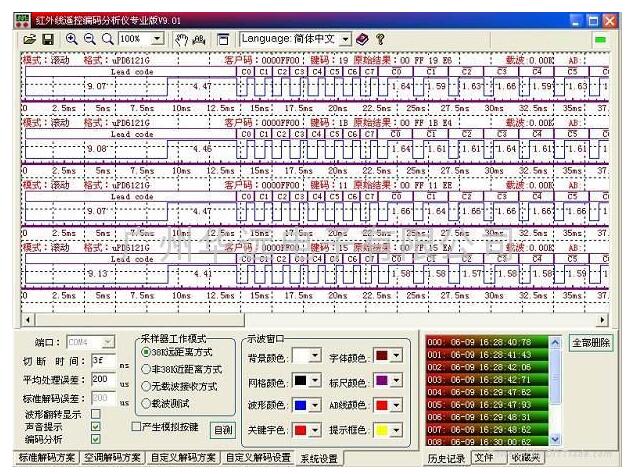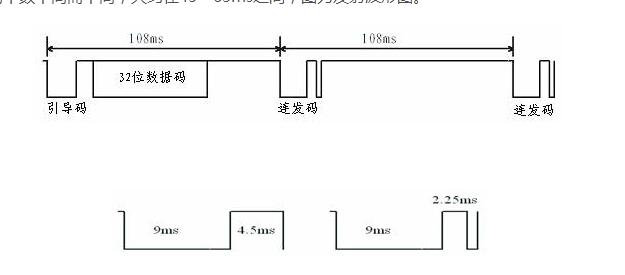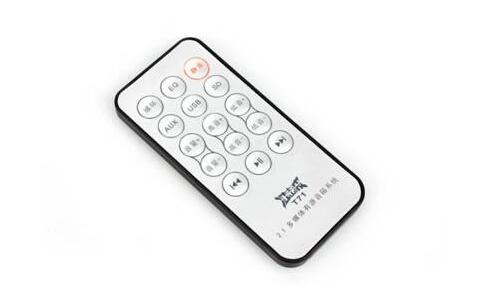A detailed explanation of the infrared remote control module working principle
Infrared remote control is a kind of wireless and non-contact control technology, with strong anti-interference ability, reliable information transmission, low power consumption, low cost, easy to achieve and other significant advantages, widely used by many electronic devices, especially home appliances, and more and more Many applications to computers and mobile phone systems. This article first introduced the basic principle of the infrared remote control module, followed by a detailed explanation of the infrared remote control module working principle, and finally introduced an important part of infrared remote control and application.
The basic principle of infrared remote controlThe infrared remote control transmitter circuit uses infrared light emitting diodes to emit modulated infrared light waves. The infrared receiver circuit is composed of infrared receiver diodes, triodes, or silicon photocells. They convert the infrared light emitted by the infrared emitter into corresponding electrical signals, and then send them. Amplifier.
Transmitters are generally composed of instruction keys (or joysticks), instruction encoding systems, modulation circuits, driver circuits, and transmitter circuits. When the instruction key is pressed or the operation lever is pushed, the instruction encoding circuit generates a required instruction encoding signal, the instruction encoding signal modulates the carrier, and then the power is amplified by the driving circuit and then transmitted outward by the transmitting circuit. signal.
The receiving circuit is generally composed of a receiving circuit, an amplifying circuit, a modulating circuit, an instruction decoding circuit, a driving circuit, and an executing circuit (mechanism). The receiving circuit receives the modulated coded command signal sent by the transmitter, and sends it to the demodulation circuit after amplification. The demodulation circuit demodulates the modulated command coded signal, that is, it is converted into a coded signal. The instruction decoder decodes the coded instruction signal. Finally, the drive circuit drives the execution circuit to implement the operation control (mechanism) of various instructions.
Infrared remote control module working principlePress a button on the remote control, the remote control will send out a series of modulated signals. After this signal is received by the infrared integrated module, it will output the demodulated digital pulses. Each button corresponds to a different pulse, so the recognition is different. The pulse can identify different keys.

The figure above is a very common car MP3 remote control, relatively small, very good use. The following is the principle of infrared emission and reception:

To this reader may be puzzled, then the pulse rule that different modulation and demodulation methods come out is different? Yes, it is indeed.
There are many special chips for remote control transmitters. According to the coding format, they can be divided into two categories. Here, we use a more widely used and relatively easy-to-decode class to illustrate. Now we use the uPD6121G transmission circuit of NEC as an example to illustrate the coding principle (general family DVD, VCD, and audio are all used in this encoding method). When the transmitter button is pressed, a remote control code is issued, and the pressed keys have different remote control codes. This remote control code has the following features:
Using a pulse width modulated serial code, a binary "0" is represented by a combination of a pulse width of 0.565 ms, an interval of 0.56 ms, and a period of 1.125 ms; a combination of a pulse width of 0.565 ms, an interval of 1.685 ms, and a cycle of 2.25 ms The binary "1" is shown in the waveform.

As can be seen, the low levels of the 0 and 1 front ends are both 0.56 ms, which is different from the high level of the following high level. 0 is 0.56 ms, and 1 is 1.685 ms. When the difference is found, it is recognized when programming. Based on!
The 32-bit binary code composed of the above “0†and “1†is secondarily modulated by a carrier frequency of 38 kHz to increase the emission efficiency and achieve the purpose of reducing the power consumption of the power supply. Then infrared radiation is emitted into the space through infrared emitting diodes, as shown in the figure.

The remote control code generated by the UPD6121G is a continuous 32-bit binary code group, in which the first 16 bits are user identification codes, which can distinguish different electrical equipment and prevent different types of remote control codes from interfering with each other. The user ID of the chip is fixed at 01H in hexadecimal; the last 16 bits are 8-bit opcodes (function codes) and their inverse codes. UPD6121G Up to 128 different combinations of codes.
See the figure below, from the network:

When a key is pressed for more than 36ms, the oscillator activates the chip and will transmit a set of 108ms coded pulses. The 108ms transmit code consists of a boot code (9ms), a result code (4.5ms), and a low 8bit address code (9ms). ~18ms), high 8-bit address code (9ms~18ms), 8-bit data code (9ms~18ms) and the inverted data of these 8-bit data (9ms~18ms). If the key is pressed for more than 108ms and has not been released, the next transmitted code (sending code) will consist of only the start code (9ms) and the end code (2.25ms). (In fact, the action of the human hand is very slow. Even if you press the button quickly, it may still be more than 108ms for the chip, so how to deal with the serial number is very critical)
After the key is pressed, the remote controller periodically emits the same 32-bit binary code with a period of approximately 108 ms. The duration of a set of codes varies with the number of binary “0s†and “1s†it contains, approximately between 45 and 63 ms, and the figure shows the transmitted waveform.

Infrared remote control devices include infrared emission (ie, remote control) and infrared reception. Since almost all objects are constantly emitting infrared rays, how can we ensure that the control signal transmitted by a given remote control can be accurately received by the receiving device without interference from other signals? This requires the following Four links to control.
1. Infrared Sensor Supporting The use of an infrared emission sensor and an infrared receiver sensor together form an infrared remote control system.
Remote-control infrared emission sensors, that is, infrared light-emitting diodes, are made of semiconductor materials such as gallium arsenide or arsenic arsenide, and the former has lower luminous efficiency than the latter. The peak wavelength is the light emission wavelength corresponding to the maximum infrared light intensity emitted from the infrared light emitting diode. The peak wavelength of the infrared light emitting diode is usually 0.88 μm to 0.995 Am. There are two types of infrared receivers for remote control: photodiodes and phototransistors. The response wavelength (also known as the peak wavelength) reflects the spectral response characteristics of photodiodes and phototransistors. It can be seen that it is very important to increase or decrease the efficiency of the collection. The peak wavelength of the infrared light emitting diode used in the remote control system and the response wavelength of the infrared receiving sensor must be the same or similar.
2. Signal modulation and demodulation The infrared remote control signal is a series of binary pulse codes. In order to prevent it from being interfered with by other infrared signals in the wireless transmission process, it is usually first modulated at a specific carrier frequency, and then transmitted through the infrared light emitting diodes, and the infrared receiver device will filter out other clutter only. Receive this particular frequency signal and restore it to a binary pulse code, that is, demodulation. The following figure shows the infrared emission and reception. The state in which no signal is transmitted in FIG. 1 is referred to as a space number or a 0 state. A state in which a signal is transmitted in a pulsed manner at a certain frequency is referred to as a mark or a state. In infrared remote control systems for consumer electronics products, the carrier frequency of infrared signals is usually 30 kHz--OkHz, and the standard frequencies are 30 kHz, 33 kHz, 36 kHz, 36.7 kHz, 38 kHz, 40 kHz, and 56 kHz. Other frequencies in this range can also be identified.
3, encoding and decoding
Since the infrared remote control signal is a series of binary pulse codes, then what kind of space number and combination of code numbers are used to represent the binary numbers "0" and "1", that is, the encoding method adopted for signal transmission, and also the infrared remote control signal The sender and receiver need to be agreed in advance. Generally, there are three encoding methods used in infrared remote control systems:
1) FSK (Shift Keying) Mode
The frequency shift keying method uses two different pulse frequencies to respectively represent the "0" and "1" of the binary numbers. The following figure shows the coding of "0" and "1" using frequency shift keying.
2) PPM (Pulse Position Code)
In the pulse position pairing mode, the time occupied by each binary number is the same, except that the position of the mark pulse is different. The space number is preceded by a "1" followed by the pass number, and the pass sign is followed by a "0". The following figure shows the encoding of "0" and "1" using pulse position encoding.
3) PWM (Pulse Width Coding)
Pulse width coding is based on the width of the mark pulse to distinguish between binary "0" and "1".
The width of the mark pulse is "1", the narrow mark pulse is "0," and each binary bit is used between

Since the infrared remote control does not have the ability to control the controlled object through obstacles like a radio remote control, it is not necessary to design an infrared remote controller for a home appliance like a radio remote controller, each set (transmitter and receiver). There must be different remote control frequencies or codes (otherwise, it will control or interfere with neighboring home appliances), so infrared remote controls of similar products can have the same remote control frequency or code, and no remote control signal “chain door†will appear. Case. This provides great convenience for mass production and popularization of infrared remote control on home appliances. Since infrared light is invisible light, it has little effect on the environment, and then the wavelength of infrared light fluctuation is much smaller than the wavelength of radio waves, so infrared remote control will not affect other home appliances, nor will it affect nearby radio equipment.
10 Mm Nano Tip,Smart Board Touch Screen Pen,Electronic White Board Pen,Infrared Touch Screen Pen
Shenzhen Ruidian Technology CO., Ltd , https://www.szwisonen.com